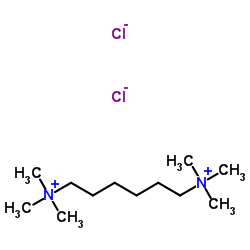a,w-bis(trimethylammonium)hexane dichloride

a,w-bis(trimethylammonium)hexane dichloride structure
|
Common Name | a,w-bis(trimethylammonium)hexane dichloride | ||
|---|---|---|---|---|
| CAS Number | 60-25-3 | Molecular Weight | 273.286 | |
| Density | N/A | Boiling Point | N/A | |
| Molecular Formula | C12H30Cl2N2 | Melting Point | 292 °C(dec.) | |
| MSDS | Chinese USA | Flash Point | N/A | |
|
Nicotine stimulation increases proliferation and matrix metalloproteinases-2 and -28 expression in human dental pulp cells.
Life Sci. 135 , 49-54, (2015) Dental pulp is the specialized tissue responsible for maintaining tooth viability. When tooth mineralized matrix is damaged, pulp is exposed to a plethora of environmental stimuli. In particular, in smokers, pulp become exposed to very high concentrations of ... |
|
|
A potentially novel nicotinic receptor in Aplysia neuroendocrine cells.
J. Neurophysiol. 112(2) , 446-62, (2014) Nicotinic receptors form a diverse group of ligand-gated ionotropic receptors with roles in both synaptic transmission and the control of excitability. In the bag cell neurons of Aplysia, acetylcholine activates an ionotropic receptor, which passes inward cur... |
|
|
Neuronal somata and extrasomal compartments play distinct roles during synapse formation between Lymnaea neurons.
J. Neurosci. 34(34) , 11304-15, (2014) Proper synapse formation is pivotal for all nervous system functions. However, the precise mechanisms remain elusive. Moreover, compared with the neuromuscular junction, steps regulating the synaptogenic program at central cholinergic synapses remain poorly d... |
|
|
Inhibitory input to the direction-selective ganglion cell is saturated at low contrast.
J. Neurophysiol. 114 , 927-41, (2015) Direction-selective ganglion cells (DSGCs) respond selectively to motion toward a "preferred" direction, but much less to motion toward the opposite "null" direction. Directional signals in the DSGC depend on GABAergic inhibition and are observed over a wide ... |
|
|
Role of nitric oxide in the control of the gastric motility within the nucleus ambiguus of rats.
J. Physiol. Pharmacol. 63(6) , 623-9, (2012) This study aims to investigate whether exogenous nitric oxide (NO) plays a role in controlling gastric motility within the nucleus ambiguus (NA). Experiments were performed on male Wistar rats anaesthetized with chloral hydrate. A latex balloon, connected to ... |
|
|
Rapid sensitization of physiological, neuronal, and locomotor effects of nicotine: critical role of peripheral drug actions.
J. Neurosci. 33(24) , 9937-49, (2013) Repeated exposure to nicotine and other psychostimulant drugs produces persistent increases in their psychomotor and physiological effects (sensitization), a phenomenon related to the drugs' reinforcing properties and abuse potential. Here we examined the rol... |
|
|
The ethanol-induced stimulation of rat duodenal mucosal bicarbonate secretion in vivo is critically dependent on luminal Cl-.
PLoS ONE 9(7) , e102654, (2014) Alcohol may induce metabolic and functional changes in gastrointestinal epithelial cells, contributing to impaired mucosal barrier function. Duodenal mucosal bicarbonate secretion (DBS) is a primary epithelial defense against gastric acid and also has an impo... |
|
|
Long-term oral melatonin administration reduces ethanol-induced increases in duodenal mucosal permeability and motility in rats.
Acta Physiol. (Oxf.) 212(2) , 152-65, (2014) Increased intestinal epithelial permeability is associated with intestinal inflammation and dysfunction. The aim of the present study was to investigate the role of long-term oral melatonin administration on ethanol-induced increases in duodenal mucosal perme... |
|
|
Aging decreases L-type calcium channel currents and pacemaker firing fidelity in substantia nigra dopamine neurons.
J. Neurosci. 34(28) , 9310-8, (2014) Substantia nigra dopamine neurons are involved in behavioral processes that include cognition, reward learning, and voluntary movement. Selective deterioration of these neurons is responsible for the motor deficits associated with Parkinson's disease (PD). Ag... |
|
|
Role of posterior hypothalamus in hypobaric hypoxia induced pulmonary edema.
Respir. Physiol. Neurobiol. 205 , 66-76, (2014) To investigate the role of posterior hypothalamus and central neurotransmitters in the pulmonary edema due to hypobaric hypoxia, rats were placed in a high altitude simulation chamber (barometric pressure-294.4 mmHg) for 24 h. Exposure to hypobaric hypoxia re... |